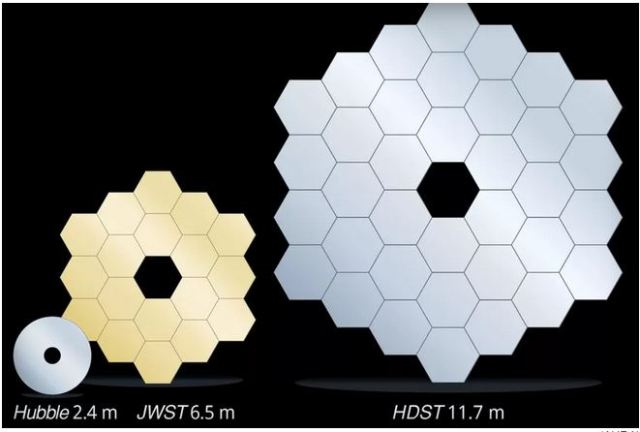Jul 7 2015
 Image Credit: AURA
Image Credit: AURA
The Association of Universities for Research in Astronomy (AURA) has announced its plans to develop the High Definition Space Telescope (HDST), an advanced high-definition space observatory with an aim to succeed NASA’s James Webb Space Telescope (JWST).
The proposed HSDT consists of a primary mirror, which is double the size of JWST and has a 40ft width. The telescope must be placed at the second Earth-Sun Lagrange point (L2) which is at a distance of about 1 million miles from Earth.
The main goal of the proposal is to directly image a number of Earth-like exoplanets across the Universe. This concept was presented by AURA at the American Museum of Natural History in a panel discussion headed by Neil deGrasse Tyson.
JWST is a successor to the Hubble Space Telescope and is yet to be launched by NASA. It will deeply investigate the Universe using infrared and will likely be launched in 2018. AURA presented a report on the successor of Hubble in 1996 and the concept was eventually led to the development of the JWST. However, AURA decided to think beyond the JWST. It believes that HSDT is as an ideal solution for the next 25 years.
The new telescope can be considered as the closest successor of the JWST, which is presently called the next-generation space telescope and has excelled the ability and scope of the Hubble. The JWST will also be positioned at the second Earth-Sun Lagrange point, but with a general goal.
Using infrared, the telescope will study the galaxies that are nearly 13 billion light years away. The age of the Universe is reported to be around 13.8 billion years. Therefore, the light observed from the galaxies will be from their initial stage of formation or when they were at their younger age. As a result, the rise of the early cosmos can be observed.
Although AURA favors JWST, it believes that astrophysicists require a different telescope that satisfies a more specific goal. The group stated that some of the biggest questions remain unanswered besides various discoveries: "Are we alone in the Universe? Are other Earth-like worlds common? Do any have signs of life? How did life emerge from a lifeless cosmic beginning?". AURA declared that the queries can be resolved with a suitable telescope.
HDST is one such telescope that can answer all the questions. Following its launch, the telescope will image exoplanets revolving around a myriad of stars. The goal of this telescope is same like that of the NASA’s Kepler mission to identify Earth-like planets around the stars in the Milky Way Galaxy. With the information obtained from Kepler and other Earth-based observations, nearly 2000 exoplanets have been observed in the Universe.
Most of the planets cannot be directly observed. However, nearly 11 billion Earth-size planets have been reported around Sun-like stars in the popular "habitable zones" in the Milky Way Galaxy alone. These zones are regions present around stars where planets are able to support liquid water.
Therefore, AURA plans for an improved telescope that investigates all these regions. Hence, it proposed HDST, which is a typical James Webb telescope combined with a Kepler mission. HDST directly images the exoplanets. As of now, indirect imaging methods are used to list exoplanets, including studying the periodic dimming caused by the crossing of exoplanets in front of their host stars.
However, the HDST enables observation of dim light thrown directly by the planet, with the help of wavelengths in the range of ultraviolet to near-infrared. This allows the observatory to directly investigate a critical parameter - planet's atmosphere so as to determine if the space rocks are fit for life. AURA, with an adequate sample of planetary atmospheres, claims that the "telltale" signs of life be likely observed.
If life is rare, HDST will take us from our current complete ignorance of the occurrence rate of inhabited worlds to a first constraint, potentially showing how remarkable our own existence is. If life is common, a large sample of terrestrial worlds with highly unusual atmospheric chemistry will secure our belief that life of some kind exists beyond the Earth, regardless of possible false positives.
Certain technologies that are essential to transform HDST into reality have not yet been developed. Astronomers will require a yet-to-be developed technique called starlight suppression to precisely capture an exoplanet's atmosphere. The exoplanets are generally hard to see due to the incredibly bright host stars.
Certain exoplanets are dimmer than their host stars by 10 billion times. Theoretically, starlight suppression can suppress starlight to one part per 10 billion, thus making direct observation of orbiting planets possible.
Following the launch of Kepler mission, the presence of other Earthlike planets in the habitable zones has been identified through indirect observation methods, which make it hard to identify the atmospheres around the planets. The planets need to be directly observed to determine if we are alone out there.